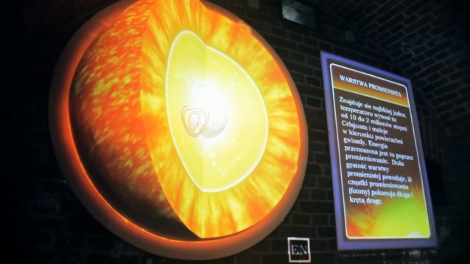
A few common components come together to make this interactive museum exhibit that teaches about the sun (translated). It uses three main physical components to pull this off. The first is a custom projection surface. It’s a hemisphere of the sun with a slice cut out of it. This is presumably coated with the paint you’d use to turn a wall into a projection surface. Software translates a projected image to map correctly on the topographic surface, resulting in what you see above, with a Kinect for user input.
Take a look at the video embedded after the break to see how the exhibit works. It instructs patrons to stand on a pair of footprint markers on the floor. This positions them at the proper range from a Kinect depth camera, which translates their outline into cursor commands. By moving a hand around they can explore the different parts of the sun.
We’re in love with how easy this type of interaction is becoming. Granted, there’s a fair amount of work that goes into to the coding for the project, but the physical build is quick and relatively inexpensive.
[vimeo http://vimeo.com/22543837 w=470]
[Thanks Lukasz]














Looks like a great museum!
any idea of the software he’s using @1.57 to map the projection ?
Museums should keep hackers on staff to come up with shit like this as needed.
worst use of this hardware i have ever seen
who wants to wave their hand around to learn about layers of the sun? it looks tiresome to hold your hand still while reading the description.
people are going to say it will get kids interested, but kids wont use it to learn, they do the same as any interesting museum exhibit, and mess around on it so no one else can use it
The one redeeming feature this has over traditional interface is kids cant put their disgusting slimy hands all over it and give everyone else their horrid diseases.
poor usage, decent implementation (i suppose)
C+
That software looked like some sort of deform mesh that you could erase and manipulate like in photoshop.
I’m WAY more interested in that than I am the installation.
this is great and people who think people don’t want to learn should give a little credit perhaps pick up a book and stop being so critical of others efforts. The software??? Yes please! I would like to know more about that. Great post and great use of hardware and software.
@dwan, @Renee: There was custom software used in this installation (c#, XNA, openCV, emguCV) – only this way we could made it interactive. For projection mapping, however, you can try resolume with Ir Mapio.
@pff: “who wants to wave their hand around to learn about layers of the sun?” – apparently a lot of people, as it became really popular installation.